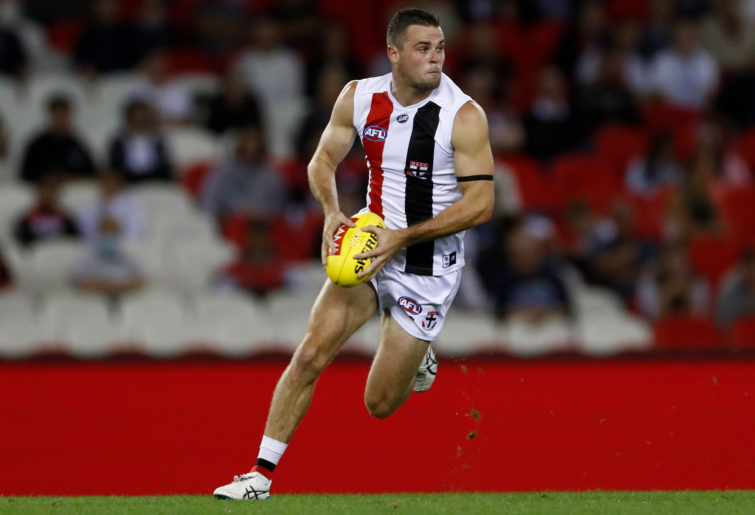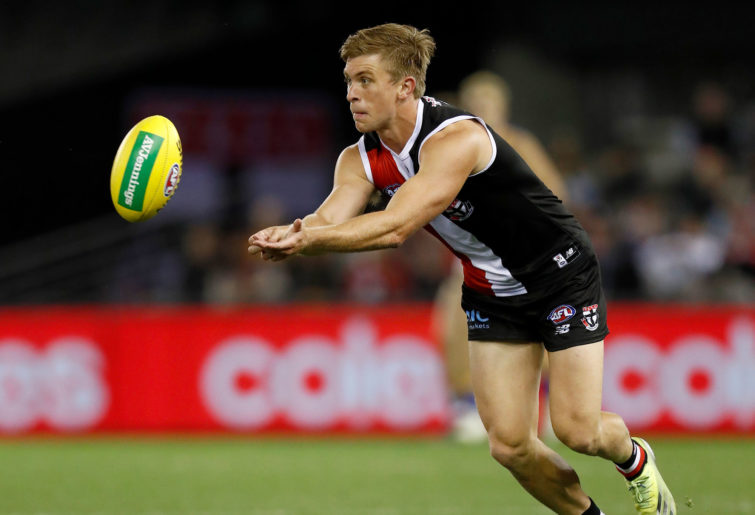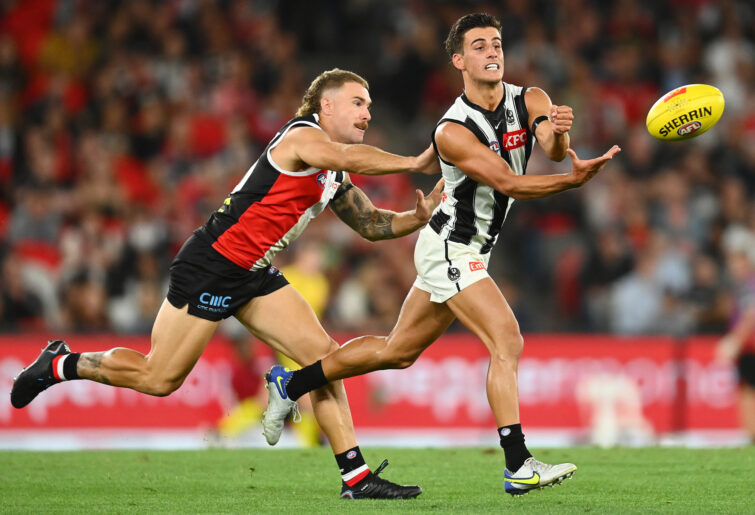Let’s settle down when discussing the Saints.
It has been a really impressive start to the season without question and to express concerns, I must first acknowledge the positives that we’ve seen so far.
Through the first six rounds, they sit fifth with a record of 5-1 and have clearly exceeded expectations.
The Saints have done it at both ends, conceding the third fewest points while scoring the fourth most points and most encouragingly, the over-reliance on Jack Steele hasn’t been there in 2022.
Perhaps the single biggest leap undertaken by St Kilda has been the vast improvement in fitness – arguably the most vital asset to work off in modern footy, combined with defensive commitment.
This has seen some marked improvements from specific individuals that previously have been as maligned as any across the competition.
Take the trio of Brad Crouch, Seb Ross and Dan McKenzie, for example. All three have been prominent midfielders for the Saints in 2022, with McKenzie transforming himself into one of the best two-way running wingmen in the competition.

(Photo by Darrian Traynor/Getty Images)
Among the justifiable criticisms levelled at these players was their application to the defensive side of the game.
If you want to question whether there’s enough belief in this playing group, look no further than the increases in defensive-half pressure acts among these players.
Crouch has gone from averaging 9.2 per game to 11.7, McKenzie has increased his from 6.7 to 8.5 and somewhat surprisingly, Ross has jumped from 6.5 defensive-half pressure acts per game to an excellent 9.8.
This is absolutely significant to keep in mind when analysing St Kilda, as these players are playing central positions and providing comparable defensive support to Steele, who had very little previously.
The case of Ross warrants a little further attention, as he’s deserving of credit from those who have previously treated him as a whipping boy.
Before the season, the 28-year-old may have found himself on the fringes of a fully fit St Kilda team.
He has won best-and-fairest awards previously and been among the league’s most prolific ball-winners, but a long-held criticism of Ross has been his poor ball use and lack of overall impact on games.
Even as recently as last season, the midfielder seemed to be struggling to maintain relevance.
But a quarter of the way through 2022, Ross has been a perfect complementary piece of the midfield.
Ross’ kicking efficiency is 66.7 per cent on 12 kicks a game, a clear career-high in ball use and rated above average across midfielders in the league.

(Photo by Darrian Traynor/AFL Photos/via Getty Images)
His contested possession rate has pushed back up among his career-best, he’s averaging more intercept possessions than ever before, he’s ranked 16th in the entire league for score involvements and as mentioned, his defensive pressure is better than ever.
Backing in Ross has worked out swimmingly, as has the move of Jack Sinclair back into the midfield.
Sinclair is ranked in the league’s top 20 for effective disposals and metres gained, and he’s averaging career-highs in disposals, clearances, ground-ball gets and tackles.
Perhaps the Saints missed the craft and skill of Jade Gresham more than the general AFL fan realised. He has returned to be one of the AFL’s best players for goal assists, inside 50s and centre clearances, he is averaging 24 disposals, six inside 50s, four clearances, and he has kicked nine goals in six games.
Of course, I could endlessly list the positive output of many players, although Josh Battle, Max King and Jack Higgins are deserving of specific individual mentions.
Yet for all the positives, and there are plenty, to suggest the Saints have graduated to even remote premiership contention is to overreact on what has been presented to us.
For those who haven’t kept tabs, the Saints lost to Collingwood in the first round and have subsequently beaten Fremantle, Richmond, Hawthorn, Gold Coast and GWS.
While the only true contender they’ve played so far was an away win against the wildly inefficient Dockers, this isn’t an exercise in criticising a softer draw – in fact, we should commend a finals aspirant for putting in the work against rivals.
Rather, it’s the tactical and stylistic approach that are of concern.

(Photo by Quinn Rooney/Getty Images)
The Saints have been victorious by being able to run out games and grind their way to the very end.
There’s certainly an admirable quality about a group who can be tougher for longer and simply work their way to wins, but that should be a trait rather than an identity.
Sure, in pockets, the Saints have been devastating. They ran rampant in the final quarter of their win against the Tigers after grinding the opposition into the ground, while a second-quarter blitz against the Hawks set up the huge victory when Hawthorn tried to take blind risks later in the game and turned the ball over.
Instead, Round 6’s win against GWS was the epitome of a fighting victory and St Kilda’s norm, having lost Jack Hayes and Rowan Marshall. They preyed on a team devoid of confidence and ran right over them.
Unfortunately, genuinely good teams aren’t that easy to grind down with patient ball use and in fact, slower ball movement is a huge red flag in 2022.
Collingwood beat St Kilda with quick ball movement and efficient transition. They didn’t stay still if they could help it and would go direct as often as possible.
That’s exactly the way the likes of Melbourne, Brisbane and Sydney play, while a fit Fremantle and Geelong do it plenty.

(Photo by Paul Kane/Getty Images)
These teams wait for the opposition to slow down their ball use and chip the ball around. With each disposal that purely aims to retain possession, they move higher up the ground and squeeze teams until they turn the ball over closer to goal.
It’s bad news for the Saints, who are in the league’s top four for disposals-per-inside 50, averaging 7.5. For reference, Gold Coast average 5.66 disposals per inside 50, Brisbane average 6.44 and the Swans are around 6.42.
St Kilda’s numbers are comparable with Carlton in this area, and the Blues were annihilated by Fremantle by over-possessing and being caught out by forward pressure and direct disposals.
The sustainability of relying on contested marking inside 50 to score is also a legitimate concern.
King is the league’s best inside-50 target and has been quite incredible so far, kicking 17.17 with 4.7 marks inside 50 and 2.8 contested marks per game.
If King was able to keep up this pace across the whole season though, he’d be creating AFL records for key forwards by considerable margins.
Jack Higgins, too, is averaging inordinate numbers inside 50 that have proven to be outliers in the competition previously, rather than an accepted norm.
Right now the numbers are impressive, but to think this could be sustainable is surely wishful thinking.

(Photo by Darrian Traynor/Getty Images)
A strength of the Saints in 2021 was their average of 11.1 tackles inside 50, which has dropped to 9.5 this season. They’ve improved from 12th to sixth in clearances, but a lot of lateral ball movement almost neutralises this advantage.
Clearly, work has been done to solidify the group defensively – the Saints concede the second fewest marks inside 50, yet it’s mainly due to the midfield group pushing back and occupying defensive space. Callum Wilkie and Dougal Howard have actually been average in one-on-one contests.
As a result of the increased ground ball out back and the desire to retain possession, no team attracts more pressure, with St Kilda’s opponents averaging 14.2 tackles inside 50.
Unfortunately for the Saints, the fixture isn’t particularly kind to them.
Stats Insider has the club facing the most difficult fixture by far, featuring two games against Brisbane, Geelong and Sydney while needing to face Melbourne, Fremantle and Carlton and having sold what should’ve been a straightforward home game against Port Adelaide.
Winning five of their first six games provides the Saints with some luxuries, such as being able to afford a slip-up on occasion, but with this hard a fixture against teams preying on slow ball movement, Brett Ratten simply must make some tactical adjustments – and quickly – as his team cannot grind out wins against this quality opposition.
A potential ten-goal loss against Melbourne looms without change and would be a devastating wake-up call.
The Saints have had a wonderful start to 2022 and have exceeded the expectations of most.
They must be careful in navigating a difficult few months ahead if they want don’t want to slip to the fringes of the finals.
We should celebrate what the St Kilda Football Club have achieved in the opening stanza of 2022, but tempering expectations is vital to properly judge the group going forward.

































































































